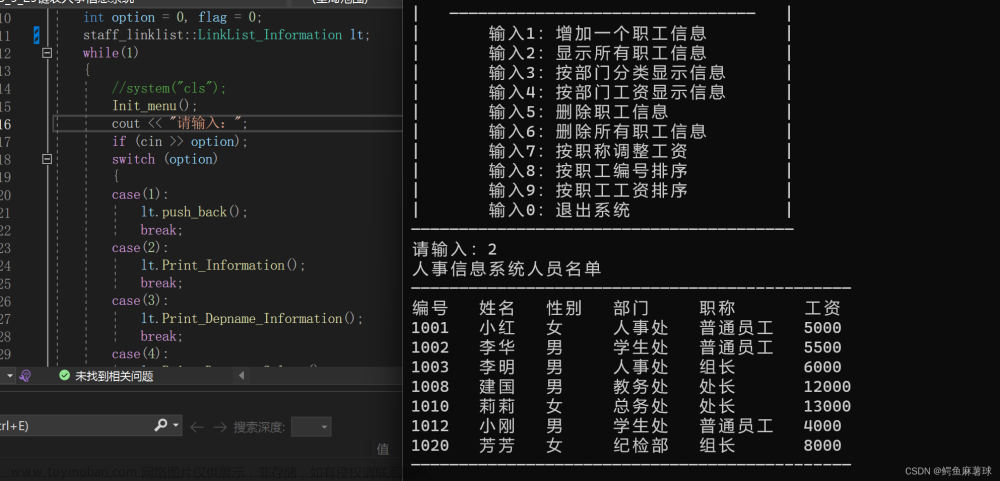前言:当我们想要挪动大量数据的时候,单链表的效率就很低了,比如尾插,要找到尾,通过遍历的时间复杂度最坏情况是O(N),所以我们引进结构复杂但效率高的双向带头循环链表
带头双向循环链表
带头双向循环链表指得是什么呢?就是既存储了上一个节点的地址,又存储了下一个节点的地址,带有哨兵位,加上哨兵位的头指向了链表的尾,链表的尾的下一个指向了哨兵位的头
定义
和单链表一样,有指针域和数据域,不过比单链表多了一个存储上一个节点的指针
typedef struct ListNode
{
LTDataType data;
struct ListNode* next;
struct ListNode* prev;
}ListNode;
双向链表的功能
和单链表大差不差
头插
尾插
头删
尾删
找到某个位置的下标
在任意位置插入
删除任意位置的数据
销毁链表
标明:我们先实现每个函数的接口,插入和删除用这两个函数(在任意位置插入
,删除任意位置的数据)复用效率会快好多
双向链表的功能实现
初始化
初始化需要传二级指针,因为初始化需要改变结构体指针,也就是要对头进行初始化,让头指向自己,如果传一级,就相当于传值调用,形参的改变并不会影响实参,而后面的函数接口都不用二级,因为改变的是结构体,也就是“箭头”的指向注:你可以返回结构体指针,也可以传二级指针,我们这里采用的是返回结构体指针
代码实现
ListNode* ListInit()
{
ListNode* phead = (ListNode*)malloc(sizeof(ListNode));
phead->prev = phead;
phead->next = phead;
return phead;
}
创建新节点
ListNode* BuyListNode(LTDataType x)
{
ListNode* newNode = (ListNode*)malloc(sizeof(ListNode));
newNode->data = x;
newNode->next = NULL;
newNode->prev = NULL;
return newNode;
}
打印链表
代码实现
void ListPrint(ListNode* phead)
{
assert(phead);
ListNode* cur = phead->next;
while (cur != phead)
{
printf("%d ", cur->data);
cur = cur->next;
}
printf("\n");
}
头插
首先创建个哨兵,也就是新节点,一定要先断言链表不为空哦
代码实现
void ListPushFront(ListNode* phead, LTDataType x)
{
assert(phead);
ListNode* newNode = BuyListNode(x);
ListNode* next = phead->next;
phead->next = newNode;
newNode->prev = phead;
newNode->next = next;
next->prev = newNode;
}
尾插
先定义一个尾指针,使代码清晰易懂,不用像单链表一样考虑一个节点,两个节点,多个节点的问题
代码实现
void ListPushBack(ListNode* phead, LTDataType x)
{
assert(phead);
ListNode* newNode = BuyListNode(x);
ListNode* tail = phead->prev;
newNode->prev = tail;
tail->next = newNode;
newNode->next = phead;
phead->prev = newNode;
//ListInsert(phead, x);
}
头删
当删到只剩哨兵位的话就不能删了
代码实现
void ListPopFront(ListNode* phead)
{
assert(phead);
assert(phead->next != phead);
ListNode* next = phead->next;
phead->next = next->next;
next->next->prev = phead;
ListNode* nextNext = next->next;
phead->next = nextNext;
nextNext->prev = phead;
free(next);
//ListErase(phead->next);
}
尾删
删到最后只剩哨兵位,就不要删了,链表为空,再去解引用就会报错
代码实现
void ListPopBack(ListNode* phead)
{
assert(phead);
assert(phead->next != phead);
ListNode* tail = phead->prev;
ListNode* tailprev = tail->prev;
free(tail);
phead->prev = tailprev;
tailprev->next = phead;
//ListErase(phead->prev);
}
销毁链表
循环结束的条件是当遍历到等于哨兵位时,说明已经销毁完数据了,再把哨兵位free掉就好
代码实现
void ListDestroy(ListNode* phead)
{
assert(phead);
ListNode* cur = phead->next;
while (cur->next != phead)
{
ListNode* next = cur->next;
free(cur);
cur = next;
}
free(phead);
phead = NULL;
}
查找下标
代码实现
ListNode* ListFind(ListNode* phead, LTDataType x)
{
assert(phead);
ListNode* cur = phead->next;
while (cur != phead)
{
if (cur->data == x)
{
return cur;
}
cur = cur->next;
}
return NULL;
}
在任意位置之前插入数据
 文章来源:https://www.toymoban.com/news/detail-856560.html
文章来源:https://www.toymoban.com/news/detail-856560.html
代码实现
void ListInsert(ListNode* pos, LTDataType x)
{
assert(pos);
ListNode* newNode = BuyListNode(x);
ListNode* posPrev = pos->prev;
posPrev->next = newNode;
newNode->prev = posPrev;
newNode->next = pos;
pos->prev = newNode;
}
删除任意位置的数据
 文章来源地址https://www.toymoban.com/news/detail-856560.html
文章来源地址https://www.toymoban.com/news/detail-856560.html
代码实现
void ListErase(ListNode* pos)
{
assert(pos);
ListNode* posPre = pos->prev;
ListNode* posNext = pos->next;
posPre->next = posNext;
posNext->prev = posPre;
free(pos);
pos = NULL;
}
源码
List.h
#pragma once
#include<stdio.h>
#include<stdlib.h>
#include<assert.h>
typedef int LTDataType;
typedef struct ListNode
{
LTDataType data;
struct ListNode* next;
struct ListNode* prev;
}ListNode;
ListNode* ListInit();
void ListPushBack(ListNode* phead, LTDataType x);
void ListPrint(ListNode* phead);
void ListPopBack(ListNode* phead);
void ListPopFront(ListNode* phead);
void ListPushFront(ListNode* phead,LTDataType x);
ListNode* ListFind(ListNode* phead, LTDataType x);
void ListInsert(ListNode* pos, LTDataType x);
void ListErase(ListNode* pos);
void ListDestroy(ListNode* phead);
List.c
#define _CRT_SECURE_NO_WARNINGS
#include"List.h"
ListNode* ListInit()
{
ListNode* phead = (ListNode*)malloc(sizeof(ListNode));
phead->prev = phead;
phead->next = phead;
return phead;
}
ListNode* BuyListNode(LTDataType x)
{
ListNode* newNode = (ListNode*)malloc(sizeof(ListNode));
newNode->data = x;
newNode->next = NULL;
newNode->prev = NULL;
return newNode;
}
void ListPushBack(ListNode* phead, LTDataType x)
{
assert(phead);
ListNode* newNode = BuyListNode(x);
ListNode* tail = phead->prev;
newNode->prev = tail;
tail->next = newNode;
newNode->next = phead;
phead->prev = newNode;
也处理了空链表的问题,不用像单链表一样考虑一个节点,两个节点,多个节点的问题
//ListInsert(phead, x);
}
void ListPrint(ListNode* phead)
{
assert(phead);
ListNode* cur = phead->next;
while (cur != phead)
{
printf("%d ", cur->data);
cur = cur->next;
}
printf("\n");
}
void ListPopBack(ListNode* phead)
{
assert(phead);
assert(phead->next != phead);//删到最后只剩哨兵位,就不要删了,链表为空,再去解引用就会报错
/*ListNode* tail = phead->prev;
ListNode* tailprev = tail->prev;
free(tail);
phead->prev = tailprev;
tailprev->next = phead;*/
ListErase(phead->prev);
}
void ListPushFront(ListNode* phead, LTDataType x)
{
assert(phead);
ListNode* newNode = BuyListNode(x);
ListNode* next = phead->next;
phead->next = newNode;
newNode->prev = phead;
newNode->next = next;
next->prev = newNode;
//ListInsert(phead->next, x);
}
void ListPopFront(ListNode* phead)
{
assert(phead);
assert(phead->next != phead);
ListNode* next = phead->next;
phead->next = next->next;
next->next->prev = phead;
ListNode* nextNext = next->next;
phead->next = nextNext;
nextNext->prev = phead;
free(next);
//ListErase(phead->next);
}
ListNode* ListFind(ListNode* phead, LTDataType x)
{
assert(phead);
ListNode* cur = phead->next;
while (cur != phead)
{
if (cur->data == x)
{
return cur;
}
cur = cur->next;
}
return NULL;
}
//在pos位置之前插入
void ListInsert(ListNode* pos, LTDataType x)
{
assert(pos);
ListNode* newNode = BuyListNode(x);
ListNode* posPrev = pos->prev;
posPrev->next = newNode;
newNode->prev = posPrev;
newNode->next = pos;
pos->prev = newNode;
}
void ListErase(ListNode* pos)
{
assert(pos);
ListNode* posPre = pos->prev;
ListNode* posNext = pos->next;
posPre->next = posNext;
posNext->prev = posPre;
free(pos);
pos = NULL;
}
void ListDestroy(ListNode* phead)
{
assert(phead);
ListNode* cur = phead->next;
while (cur->next != phead)
{
ListNode* next = cur->next;
free(cur);
cur = next;
}
free(phead);
phead = NULL;
}
test.c
#define _CRT_SECURE_NO_WARNINGS
#include"List.h"
void test2()
{
ListNode* plist = ListInit();
//尾插
ListPushBack(plist, 1);
ListPushBack(plist, 2);
ListPushBack(plist, 3);
ListPushBack(plist, 4);
ListPrint(plist);
//头插
ListPushFront(plist, 10);
ListPushFront(plist, 18);
ListPushFront(plist, 17);
ListPushFront(plist, 16);
ListPushFront(plist, 15);
ListPrint(plist);
/*
//在pos位置前插入
ListNode* pos1 = ListFind(plist, 3);
if(pos1)
{
ListInsert(pos1,30);
}
ListPrint(plist);
*/
/* //删除pos位置的数据
ListNode* pos = ListFind(plist, 2);
if(pos)
{
ListErase(pos);
}
ListPrint(plist);
*/
头删
//ListPopFront(plist);
//ListPopFront(plist);
//ListPrint(plist);
尾删
//ListPopBack(plist);
//ListPrint(plist);
//ListPopBack(plist);
//ListPrint(plist);
//销毁
ListDestroy(plist);
plist = NULL;
}
int main()
{
//test1();
test2();
return 0;
}
到了这里,关于带头双向循环链表的文章就介绍完了。如果您还想了解更多内容,请在右上角搜索TOY模板网以前的文章或继续浏览下面的相关文章,希望大家以后多多支持TOY模板网!













